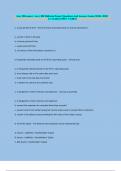Exam (elaborations)
Accy 200 exam 1, Accy 200 Midterm Exam | Questions And Answers Latest {} A+ Graded | 100% Verified
- Course
- Institution
Accy 200 exam 1, Accy 200 Midterm Exam | Questions And Answers Latest {} A+ Graded | 100% Verified
[Show more]



